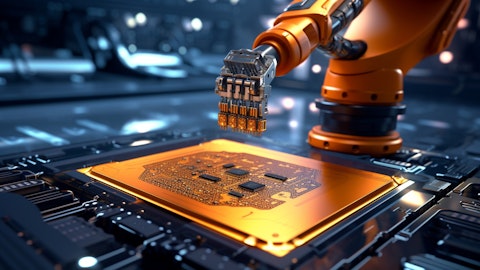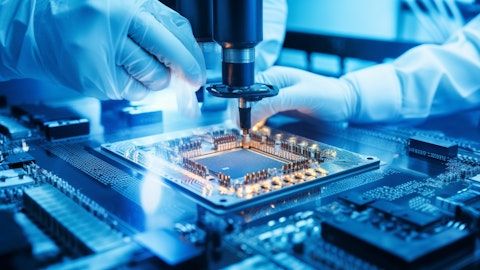David Duley: Okay. Great. Okay. Just wanted to clarify that, thank you. Also, I’ve been a little curious. We’re on the wave of the upgrade of all the data centers to more compute power AI servers. And I read lots of articles about the amount of power they’re going to be going through all of these new servers that are being deployed in the cloud and enterprise level. How will that impact your implant business over the long-term? I would think there’s a lot of power chips to control all this electricity flowing through these new AI servers. So maybe talk a little bit about how the growth in AI servers might impact the TAM of the implant market.
Russell Low: Hey Dave, it’s Russell. So actually that’s an area I’m quite excited about. I was in China recently and that was something one of the CEO’s I was talking to was saying as a next opportunity. So its not – so clearly, there’s lots of concern about how much power these data centers are using up. So it’s the generation of that power, it’s the storage that’s power of distribution that’s obviously all going to be power devices. But I’m actually interested in the cooling part and the servers themselves. The wonderful thing about silicon carbide is you can run it hotter, it’s more efficient, it generates less heat. And so those things are really exciting. But the crossover that we’re also seeing, and it’s been going on for a little while, but you might have seen yesterday in the news, Microsoft are going to invest $10 billion in renewables to supply these data centers.
So if that goes in the direction of solar and wind, then again that’s going to all be inverters again, which will be all power devices, so lots of power in that particular application.
David Duley: So that’s kind of like the backside, right, power generation for the data farms or for the cloud data centers could be a big market, but what about the AI servers themselves? Won’t they have a lot more power chips in them and therefore be more implant intensive?
Jamie Coogan: Yes. So it will depend on the design exactly, how they do their power distribution inside the servers. So there certainly will be opportunity there. As Russell said, big piece of the opportunity comes from the full dataset power in the whole data center itself, and getting the clean energy there, getting the cooling that’s required for these facilities and so forth. And so that’s a very big piece of the opportunity.
Russell Low: Yes. And Dave, just to kind of go on from that, so clearly, there’s the power chips inside of the servers, but the cooling is a significant component of the total power usage. So whether it be gallium nitride or silicon carbide chips, they can certainly run in these applications more efficiently, generate less heat and tolerate more heat. So that’s an opportunity inside the actual data center itself.
David Duley: Okay. I just had one clarification, you mentioned that the CS&I revenue now is going to be on a run rate of $250 million for 2024. Could you just remind me what the run rate was before?
Jamie Coogan: So it was – we estimated approximately $260 million. And what we’re seeing here is a little bit of moderation in utilization, which is driving that down slightly, although the team is out there working to kind of recover back to those higher numbers if possible.
David Duley: Okay, thank you so much.
Operator: Thank you. [Operator Instructions] Our next question comes from the line of Duksan Jang of – I’m sorry, of Bank of America Securities. Your line is now open.
Duksan Jang: Hi, thank you for taking my question, and good morning. So it seems like the trough is pushed out a quarter or so. Is that the right interpretation that Q2 is going to be the bottom and you’re going to see second half recovery? And alongside that in your – this quarter’s press release, we no longer see the comment that 2024 is going to be flattish year-over-year. Is that also the right interpretation that it’s going to be lower incrementally?
Jamie Coogan: Yes. No. So again, as we kind of said in our prepared remarks here, we do continue to expect an uptick in the second half performance for 2024, as you noted. The timing and magnitude of that is going to be difficult to predict with a level of clarity and certainty. Ultimately, we do have some second half drivers here that are going to benefit. This is the continued recovery that we’re seeing here in the general mature product technologies, and if that accelerates more, that’ll provide incremental opportunity upside, some degree of recovery in the memory. And then ultimately, and this is probably the strongest signal we have now at the continuation of strength that we’re seeing in the power markets. However, despite these items potentially driving lower expected volume than what was relative to our previous expectations, we’ve been laser focused as we noted on the call in our prepared remarks on gross margins.
And so despite lower volume, we do anticipate having higher gross margins in the period as well. Although, we are making some higher investments to support those future growth initiatives, which will help to offset or not help to, but will offset some of those gross margin gains. Russell noted, again, we’re on a run rate basis of about $1 billion coming out of the first half of the year is our expectation. With that second half uptick, we do see revenue levels increasing in that back half of the year, and then ultimately the split between that is probably a little bit more weighted towards the fourth quarter of the second half than it is the third.
Duksan Jang: Got it. Related to that, I think you answered in an earlier question that silicon carbide is actually seeing stronger demand than anticipated and China is doing well as well. So then is this incremental weakness primarily outside of silicon carbide? Is it memory and silicon in general mature node?
Jamie Coogan: Yes. So largely memory, right, is probably where we’re seeing a little bit of the – relative to our prior expectations, that’s where we’re seeing a little bit more weakness than what we had anticipated. Your note on silicon carbide continue to be strong is accurate. That continues to be strong. We expect that to be strong over the course of the year. It actually was a bright spot for us in our bookings in the first quarter was really driven largely by continued strength in the power side of the business. And as we think look at our quoting activity, we’re seeing a nice uptick in quoting activity through the first quarter time frame, which we do expect to lead to future orders for the business in the both the second quarter and the second half of the year.
Russell Low: And Duksan, just on your memory part of that question and comment, signs are very strong for a good memory year coming up in 2025. Everything we see with HBM using up capacity as consumer starts to recover, PCs recover, we would expect that DRAM and NAND will see a very strong recovery, probably the strongest recovery.




